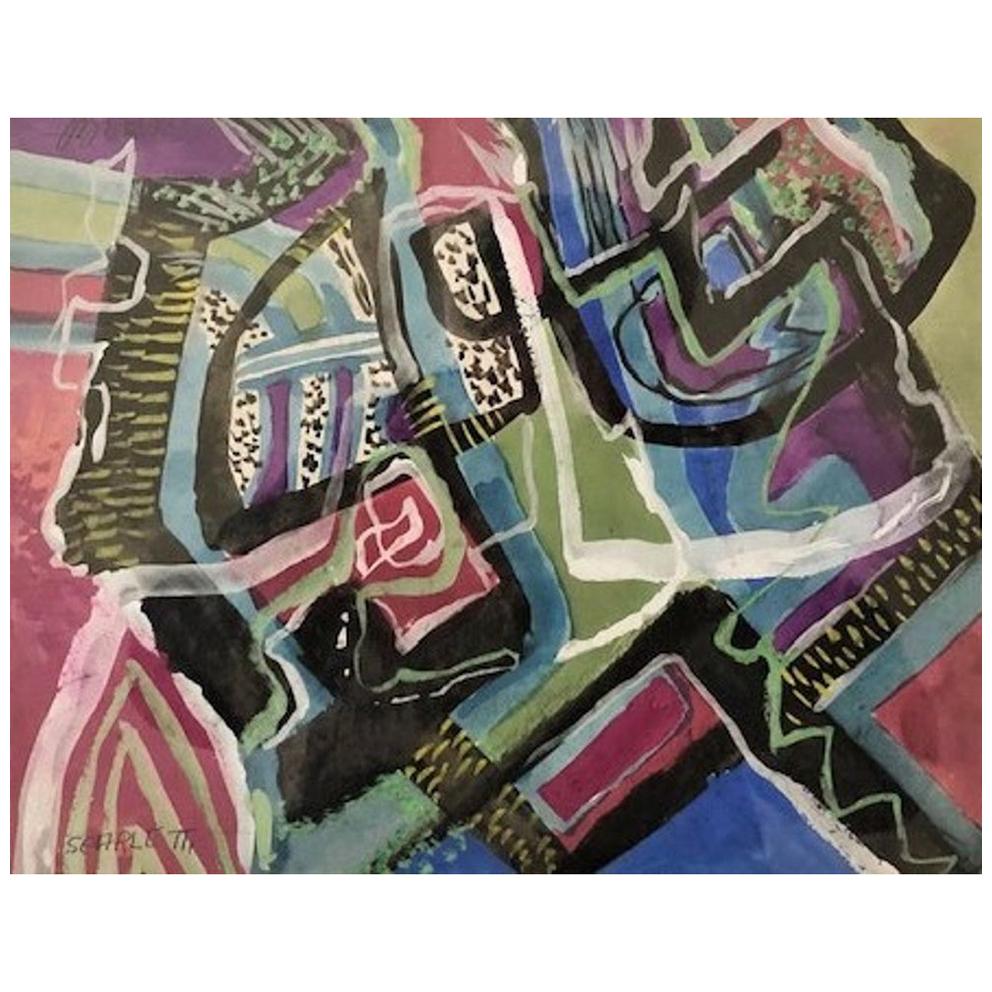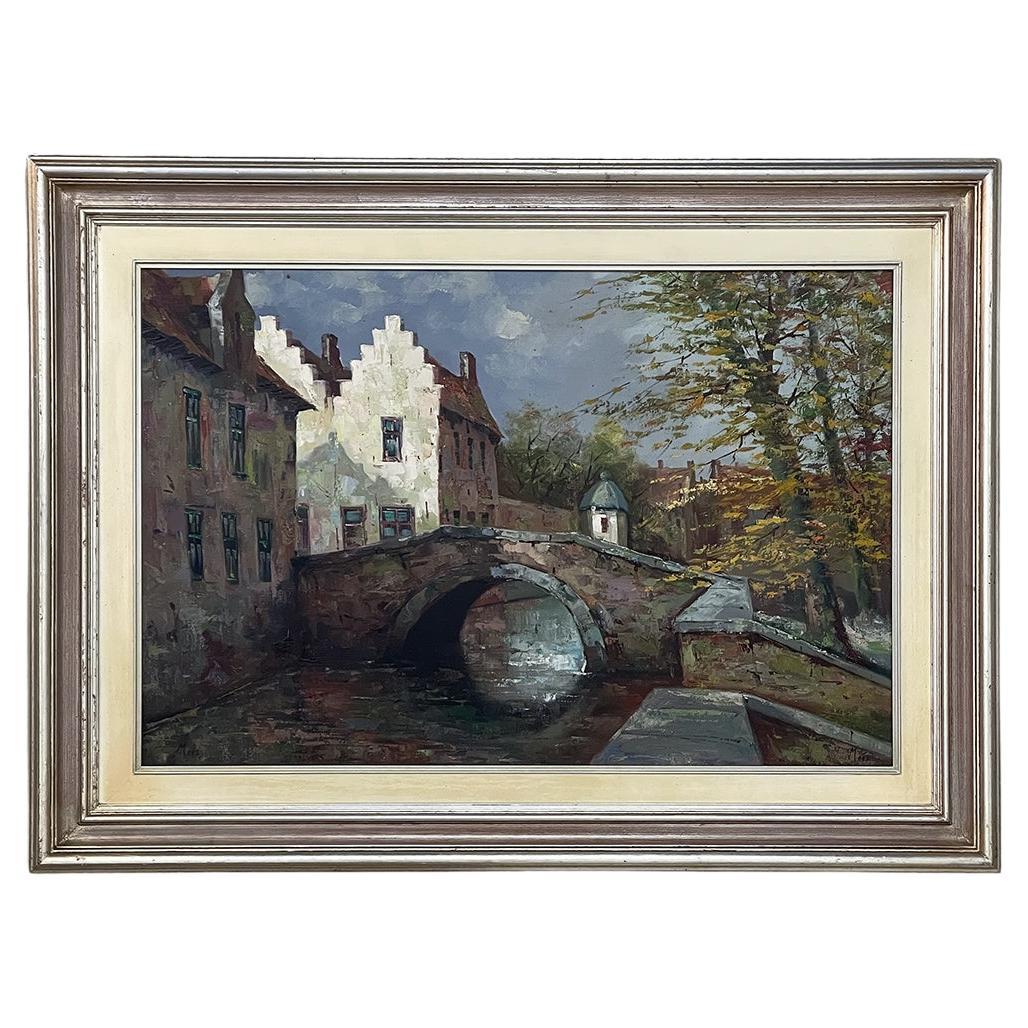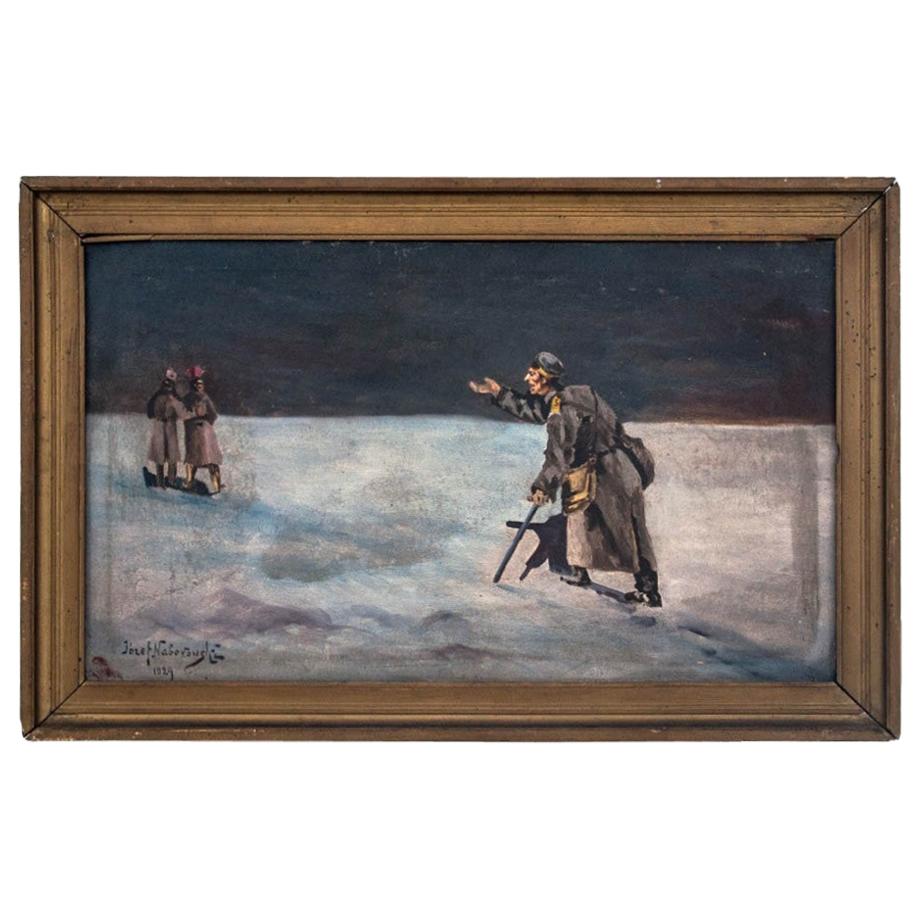Items Similar to Abstract Guache Composition by Jozef Mees, Belgian Constructivism 1976
Want more images or videos?
Request additional images or videos from the seller
1 of 11
Abstract Guache Composition by Jozef Mees, Belgian Constructivism 1976
About the Item
A colorful abstract gouache on paper by Belgian artist Jozef Mees, dated 1976. Framed behind glass with a golden frame.
Jozef Mees (1998-1987) is a Belgian visual artist who was active as a painter, architect, and interior designer. A student of Jean Delvin, Mees graduated from the Academy of Ghent in 1920. He then went to work in his family’s furniture business. Although he started his career as a cabinetmaker and decorator, he continued to nurture his creative aspirations and his artistic work was exhibited for the first time in 1924. However, it would be until after World War Two that Mees would explicitly focus on his painting developments.
Dimensions without frame: 67 x 46/With frame: 85 x 70 cm.
- Dimensions:Height: 33.47 in (85 cm)Width: 27.56 in (70 cm)Depth: 1.97 in (5 cm)
- Style:Mid-Century Modern (Of the Period)
- Materials and Techniques:
- Place of Origin:
- Period:
- Date of Manufacture:1976
- Condition:Wear consistent with age and use.
- Seller Location:Zwijndrecht, BE
- Reference Number:1stDibs: LU6567232371292
About the Seller
5.0
Vetted Seller
These experienced sellers undergo a comprehensive evaluation by our team of in-house experts.
Established in 2019
1stDibs seller since 2022
27 sales on 1stDibs
Typical response time: 2 hours
- ShippingRetrieving quote...Ships From: Zwijndrecht, Belgium
- Return PolicyA return for this item may be initiated within 3 days of delivery.
More From This SellerView All
- Oil on Canvas 'Clown' Painting by Noted Artist Jeanne Lorioz, France, 1980sBy Jeanne LoriozLocated in Zwijndrecht, AntwerpA highly decorative and charming original oil on canvas painting by the noted female French artist Jeanne Lorioz (1954). This piece dates to the 80's but no exact year is mentioned o...Category
Late 20th Century French Paintings
MaterialsCanvas, Wood
- Pair of Brass & Metal Sculptural Lamps by Georges Mathias, Belgium 1970sLocated in Zwijndrecht, AntwerpAn important pair of sculpture lamps designed by Georges Mathias in the 1970s. These lamps feature a brass base with a metal geometric tube formation on top. Both lamps are signed ...Category
Vintage 1970s Belgian Mid-Century Modern Table Lamps
MaterialsMetal, Brass
- Vintage Brass Etched 23CT Gold Table Lamp by Georges Mathias, BelgiumLocated in Zwijndrecht, AntwerpBrutalist table lamp designed by Georges Mathias in the 1970’s. Features a brass frame with a 23 carat handmade etched gold-plated front with a handmade design typical of Mathias' wo...Category
Vintage 1970s Belgian Brutalist Table Lamps
MaterialsGold Plate, Brass
- Bronze Modernist Abstract Sculpture by Grégory Anatchkov, France, 1980Located in Zwijndrecht, AntwerpAbstract bronze sculpture on a black marble base by french artist Grégory Anatchkov (1941 - 1997). This sculpture shows a very appealing organic composition and is different in prese...Category
Late 20th Century French Mid-Century Modern Abstract Sculptures
MaterialsBelgian Black Marble, Bronze
- Belgian Brutalist Bar Cabinet in Dark Oak, 1970sLocated in Zwijndrecht, AntwerpA stunning dark brown brutalist/modernist bar cabinet with graphical doors. The continuous pattern gives this sideboard a strong and eye catching...Category
Vintage 1970s Belgian Brutalist Cabinets
MaterialsOak
- Abstract Bronze Sculpture by Franco Ciuti, Italy 1970'sBy Franco BuzziLocated in Zwijndrecht, AntwerpA bronze sculpture on a natural stone base made by Italian artist Franco Ciuti in the 1970’s. Conveys the spirit of brutalist and modernist works of the period. A very decorative pie...Category
Vintage 1970s Italian Brutalist Abstract Sculptures
MaterialsStone, Bronze
You May Also Like
- Rolph Scarlett, Modernist Abstract Composition, Guache on Paper, Ca. 1950’sBy Rolph ScarlettLocated in New York, NYArtist: Rolph Scarletti (Canadian, 1889 – 1984) Object: Modernist Abstract Composition Period: Ca. 1950’s Medium: Guache on paper, framed Dimensions (unframed): Height: 9-1/3” Width: 12” Dimensions (framed): Height: 22-3/4”” Width: 25-3/4” Rolph Scarlett (Canadian, 1889 – 1984) was a consummate explorer of twentieth-century abstract painting. Never afraid of trying new styles, curious and opinionated, constantly engaged with the world around him while steadfastly aware that he was on his own path and his alone, Scarlett more than once proved to be at the artistic zeitgeist of the eras in which he lived. Exposed very early on to the work of Paul Klee through a chance meeting in Europe with the artist himself, Scarlett took up abstraction with a fervor that never diminished during his long and impressive career. To create something that had never existed before: this was Scarlett’s great cause. And that is what is most obvious when you look at Scarlett’s work—you have never seen anything quite like it. Scarlett was Canadian-born, came of age in the Midwest, and spent few important years in Hollywood, where he designed stage sets. His work from this early period echoes Klee’s use of color, his confidence in naïve, primitive forms, and his blend of abstraction and figuration. In its flat spatial qualities it prefigures the Indian Space painting of the 1940s by a decade. He moved to New York in 1933 and eventually found his first great patron at the Museum of Non-Objective Painting, directed by Baroness Hilla Rebay and art patron Solomon R. Guggenheim. Guggenheim would collect over 60 works by Scarlett for his collection, more than any other artist outside of Vasily Kandinsky and Rudolf Bauer. As a frequent exhibitor and lecturer at the Museum of Non-Objective Painting (MNOP), Scarlett honed his sensitive feel for bodies in space and capitalized on his trademark use of bright, vivacious colors into accomplished, perfectly harmonized geometric works. However, Scarlett soon morphed these hard-edged forms into a nuanced expressionistic abstraction which, at its best, seems to be populated by dancing forms that animate the canvases. Along this way he was advised by Rudolf Bauer, the German expatriate and one of the originators of non-objective painting in the teens. Bauer had the idea for the Museum, and Rebay, his champion, had found in Solomon Guggenheim a patron for manifesting it. When Bauer emigrated just before World War II, he wanted to meet Scarlett. The two became friends, and Bauer advised Scarlett on his work over the course of many years. Even in a 1979 interview, Scarlett began to tear up as he recalled his first meeting with Bauer, a man whose work he "worshipped," describing that, "It was a touching moment for me, I’ll tell you." Scarlett and Rebay also had a close, important relationship, one in which he bore the brunt of her sometimes condescending, if motherly, critiques and admonitions with tolerance and gratefulness. Eventually, though, he had to push back. In a letter from 1951 he writes, "I have noticed with growing amazement that during the past three years you have accepted less and less of my work—and, that same work, which you rejected has been accepted and shown in the best and largest shows all over this country." This period—the late 1940s to the early 1950s—did in fact correspond to Scarlett’s most critical success, and to a return to the fanciful forms and characters of his pre-war work. At the same time, he found his own rhythm and complexity using a drip style similar to, though denser and more opaque than, the one made famous by Jackson Pollock, who had worked for many years at the MNOP and with whom he shared common influences. In 1949 he had a very well received solo show in 1949 at the Jacques Seligmann Gallery, reviewed very favorably in The New York Times: "The impression made by these paintings is one of originality and strength." He was also included in a juried show "American Painting Today" at the Metropolitan Museum of Art in 1950 and in the Whitney Annual of 1951. The curator for the Whitney show in fact bypassed a selection of Scarlett’s careful geometrics in favor of a new "lyrical" drip painting—one which he describes as having had "a helluva good time" making. Rebay articulated her loss of control over Scarlett very keenly in one of her last official letters to him: "So your way ended in the horrid jungle it is in now; even a Mr. Pollock’s smearage was not bad enough for you to have a try at; and betraying yourself, you betrayed art and my faith in you, and my present disgrace by my failure to foresee such an outrageous possibility—since you even paint objectively now." Yet, despite the fact that he was moving in his own direction when the change in leadership took place at the Museum of Non-Objective Painting and Rebay was forced out as director, Scarlett was hit hard. He understood this change rightly as a betrayal by the establishment. Scarlett was a unique individual and soul, and was affected personally and philosophically by the idea that the movement with which Scarlett had aligned his talents seemed to disappear overnight, and his life’s work rendered valueless. Without the Museum’s support, Scarlett decided eventually to move to the artists’ community of Shady, New York, just outside of Woodstock. He had occasional shows throughout the years, but mostly settled down to regional obscurity. He began making jewelry, which had been his first trade, and it was following a show of his jewelry in 1975 at the Jaro Gallery, that he was rediscovered by Samuel Esses, and his wife Sandy. Samuel Esses was a successful businessman and an avid collector. He always sought out that which was unusual and, like Scarlett, was ahead of his time in many ways. For example, in 1979, Sam became enthralled with the early graffiti appearing on the New York subway trains. With the sole goal of preserving these groundbreaking yet short lived works of art he was inspired to create "The Esses Studio," a painting warehouse and workshop for graffiti artists to work in a studio, collaborate, and paint on canvas. The biggest names of graffiti writing participated—Futura, Crash, Dondi, Zephyr, and Daze to name a few. The project was well received and provided critical validation at an important time for this alternative form of abstraction to be recognized by the established art world. The success of the "Esses Studio" helped fuel an alternative fire that would propel gallerists and curators to acknowledge other street artists and provide a foundation of acceptance for the early careers of Keith Haring and Jean-Michel Basquiat. It is not a stretch to say that what Esses saw in the graffiti art of the 1970s was very similar to what he saw in 1950s-era Scarletts—something raw, honest, and melding many twentieth century influences into one unique form. Inspired by the importance of the collection and the passion of the collector, Weinstein Gallery...Category
Vintage 1950s Canadian Mid-Century Modern Paintings
MaterialsPaper
- Vintage Framed Oil Painting on Canvas by MeesLocated in Dallas, TXVintage Framed Oil Painting on Canvas by Mees is a charming post-impressionistic rendering of a quaint Belgian town along the canal. Such canals were integral to most villages, provi...Category
Vintage 1960s Belgian Aesthetic Movement Paintings
MaterialsCanvas
- Original Abstract Composition by C. AzuelosLocated in Miami, FLStunning example of the artist’s work, original color painting composite by C. Azuelos. Hand-signed on the lower right. Wonderfully decorative original with so much movement to be...Category
20th Century French Paintings
MaterialsPaper
- G. Rosso, Belgian artist. Abstract composition. Oil on canvas. Late 20th C.Located in Copenhagen, DKG. Rosso, Belgian artist. Abstract composition. Oil on canvas. Late 20th c. Signed on the back. Stamp from a gallery in Brussels. Dimensions: 50 x 40 cm.Category
Late 20th Century Belgian Modern Paintings
MaterialsCanvas
- Painting by Józef Naborowski "The Soldiers"Located in Chorzów, PLYear: 1929 Author: Józef Naborowski Dimensions: Frame: Height 49.5 cm, width 76.5 cm Picture: Height 48.5 cm, width 65.5 cm.Category
Vintage 1920s Polish Neoclassical Revival Paintings
MaterialsCanvas, Wood
- Jean Legros, Bi-Face Sculpture Composition, 1976, FranceBy Aurélie Nemours 1Located in Brussels, BERare Jean Legros (1917-1981) sculpture, composition, 1976, France. Wood pannel painted on both sides, yellow-black and red-green. Signed and dated undersid...Category
Vintage 1970s French Modern Abstract Sculptures
MaterialsWood





